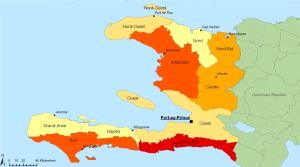 When an earthquake shook Haiti to its foundations on Jan. 12, she was one of the lucky ones. Unlike an estimated 200,000 people killed in the earthquake, she survived. And unlike other adults and several children staying at the clinic with her, the debris that fell on her didn't break her bones or require doctors to amputate her limbs.
When an earthquake shook Haiti to its foundations on Jan. 12, she was one of the lucky ones. Unlike an estimated 200,000 people killed in the earthquake, she survived. And unlike other adults and several children staying at the clinic with her, the debris that fell on her didn't break her bones or require doctors to amputate her limbs.But she was trapped and unable to move until rescuers freed her.
The human body, with its grand design of skeleton and muscle, is meant to be a poem of smooth motion. But when it is held still for days on end, as this woman's body was, the rhythm of the poetry is ruined. The concrete pressed down on her leg, and cut off the flow of blood.
When there is no relief from the tremendous pressure, the skin breaks down and splits open; and as the pressure continues, additional tissue dies.
"For some people, the pressure wound has gone so deep that it's gone all the way to the bone," said Krista Duval, a doctor of osteopathic medicine from Ohio University in Athens, Ohio. "These people will have very serious scars for the rest of their lives."
Krista was one of 18 people on a medical team that left from Quisqueya Crisis Relief Center on Thursday to run a medical clinic at at the Centre Hospitaliere du Sacré Coeur, in downtown Port-au-Prince. The medical team treated some 100 people who came to the clinic that day, as well as another 56 who have been living in tents in the parking lot of the medical center.
While several of those patients are receiving physical therapy and followup treatment to amputations that were needed after Haiti's horrific Jan. 12 quake, many others are receiving treatment for other injuries serious in their own right, such as the pressure wounds suffered by this woman.
Treatment takes time and patience. Gauze dressings must be changed at least daily, and a steady regimen of antibiotics contains the threat posed by infection.
Time, patience, and medical personnel. Most visiting medical crews leave Haiti after a week or two, and unfortunately, Haiti still lacks the infrastructure to provide the long-term medical care these patients need.
When the earthquake struck on Jan. 12, it destroyed more than an ability to provide immediate care for the victims of the quake. It also brought crashing to the ground the country's ability to provide long-term care in the weeks and months that are still to follow.
That was particularly in evidence on Friday. The medical center we visited is an 18-bed private hospital located a short distance from the wreckage of the National Cathedral. The building, although it survived the earthquake and the many aftershocks that have followed, is badly damaged. The hospital is still standing, and doctors and nurses working with teams from the Quisqueya Crisis Relief Center have been able to use its equipment, but until repairs can be made, the hospital is effectively closed.
And hospitals and medical care remain in great need. On the day I joined the medical team, there were some 100 patients who came to the clinic. That number has dropped from the average of 300 that visited the clinic when it first opened, but it remains high.
In the parking lot of the medical center stand a dozen tents, housing 56 men, women and children suffering from injuries suffered in the quake, or caring for those who had.
"Every day we discharge a few and admit one or two," said Beth Milbourne, 30, a registered nurse at Greenville Memorial Hospital in South Carolina who quit her job in the United States and moved to Haiti three weeks ago. She has been going to the clinic at the medical center every day since.
One of the patients admitted Friday was an elderly man who required an operation because of an obstructed urinary tract. Dave Drozek, a general surgeon from Ohio University who performed the surgery, spoke to me a moment about the operation as orderlies lowered the patient onto a makeshift cot under a tent in the parking lot.
"We're transitioning to more regular day-to-day needs," Dave said of the work he'd been doing that week at the clinic.
But, as he also noted, many of those needs have been delayed because of the pressing nature of the trauma inflicted by the quake.
Copyright © 2010 by David Learn. Used with permission.
Tweet
No comments:
Post a Comment